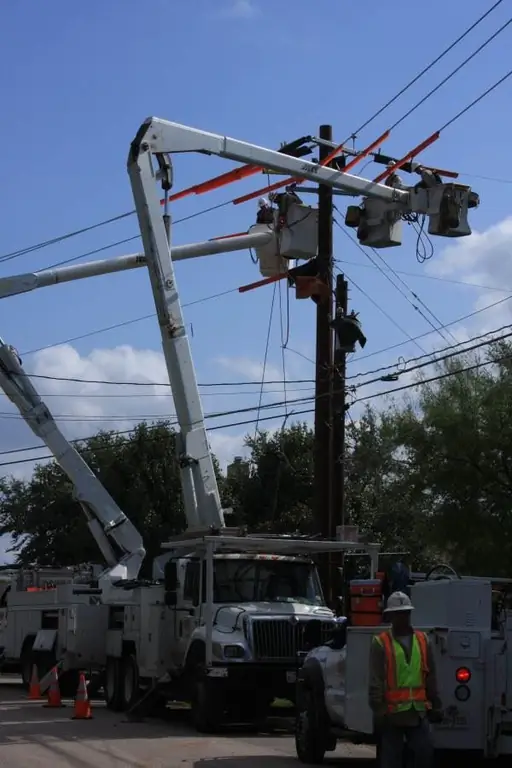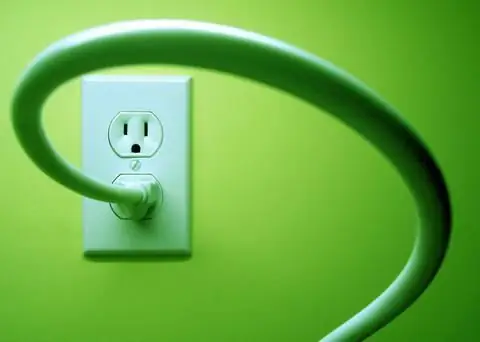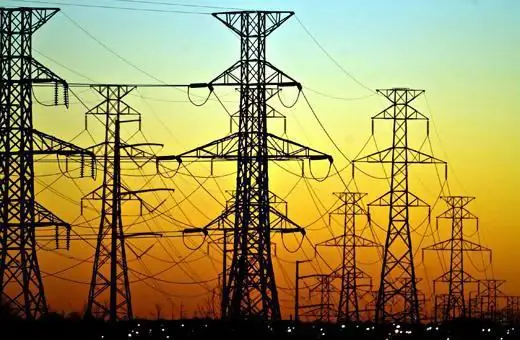2026 Author: Howard Calhoun | [email protected]. Last modified: 2025-01-24 13:10:27
An operation such as electricity metering has a specific purpose. It consists in the following: obtaining accurate information about how much was released and how much the consumer of this resource spent. This must be done in order to be able to make financial payments for electrical energy, as well as power consumption.
General information
Today, there are two types of electricity metering. Technical accounting is carried out in order to organize electricity consumption, as well as energy saving at a particular facility. There is a second type of accounting - commercial. It is used in order to be able to calculate the financial costs of the electricity used. To do this, various enterprises and facilities have specially designated places where the means of recording the consumed energy are installed.
As for the means for electricity metering, these are devices that perform only two functions. They consist in recording measurements and resource consumption. These devices also include several types. There are electric energy meters that are designed to account for active andreactive type. There are also entire transformers used to record data such as voltage and current. A separate group includes such devices as telemetry sensors, information-measuring systems, as well as their communication lines.

A measuring complex is most often installed at industrial enterprises. This is understood as a certain number of measuring instruments, which are an integral system operating according to one electricity metering scheme. There is also a more complex system for recording electricity consumption. It is presented as a combination of several measuring systems.
Common registration devices
Today, in order to successfully record data, electric meters are most often used, which are divided into two types - active and reactive, depending on what type of resource they control. In addition, among them there are meters that are connected directly to the network itself, and there are those that are connected to transformers to measure current and voltage. The essential difference is that if the electricity metering system includes a meter installed in the transformer circuit, then in order to obtain accurate data, it is necessary to multiply the data that is available on it by the calculated coefficient Kr.
For more convenient work with certain transformers, there are special counters that are initially calibrated so that they fit a certain typedevices. This is usually stated in their documentation. Such devices are usually called transformer, and it is not necessary to recalculate their readings.
There is also a separate group of devices that relate to electricity meters. Here single-phase or three-phase devices are used. They are divided into two types and can be induction or static. It is important to add that both types are electronic equipment.

Metering device
As for induction models, there is a movable type disc inside their box. A current flows through this element under the influence of the induced magnetic field of the conductive coil. In order to keep records of electricity using such devices, the following principle is used.
Alternating current and voltage that flow in a circuit have a direct effect on solid-state electronic components. This action creates an impulse, which is the output signal. The number of fixed output signals of this type is the consumption of spent active electricity.
Such devices that are used to check electricity metering must have a counting device. Most often, such a mechanism is made in the form of an electronic or electromechanical device, additionally containing a display for outputting readings, as well as a memory device. Such elements are usually used so that during an emergency power failure, the readings that were already available oncounter, do not go astray. Despite this, in recent years, the industry has been actively replacing all induction devices with electronic ones. The thing is that this type of device is capable of providing a higher measurement accuracy, it is also capable of recording and storing data, and the possibility of data transmission has become an additional function. In addition, electricity metering devices, for which acts are drawn up during installation, have a higher degree of protection against external interference. This means that it is more difficult to interfere with the operation of the device in order to change its readings to false ones.

Inclusion schemes
Another feature of the electronic meter that affects its connection scheme is the presence of multi-tariff types. Such equipment has a set of counting mechanisms. Each set will be activated at a certain time of the day, which corresponds to a certain tariff. The use of such devices has led to the fact that the consumer can choose a tariff that will be differentiated by time of day.
Further it is worth saying that there are certain features of connecting any circuits of electronic meters. The electricity metering unit, which is supplied with such a device, must be switched on according to a typical scheme, which implies the correct connection of polarities for data output. This is quite important, since it is this moment of connection that will be responsible for the correct operation of the counting mechanism, and will also help to avoid theft. The meter has generator clamps. They mustbe connected to a power source. In addition to these, there are also load terminals that must be connected to the load circuit.
When drawing up an act of accounting for electricity when installing equipment, it is necessary to ensure that the system is fully protected. Protection is necessary from such influences as external mechanical damage, exposure to external magnetic fields, as well as from unauthorized interference. In order to provide the necessary protection and be sure that it has not been violated, the installation companies of such devices install seals of two types. The first type of seals are factory ones, which are mounted on the meter body and prevent external interference in order to disrupt the operation of the meter mechanism. The second type is organization seals. With their help, financial settlements are protected.

Meter types
Installations for electricity metering in the form of active energy meters are by far the most common. It should be noted here that such devices have a different accuracy class. This coefficient indicates the largest quantitative error in the instrument readings in percent. If we talk about active energy meters, then everything depends on belonging to the class. Induction devices have the following accuracy classes: 0.5; ten; twenty; 2, 5. As for electronic, there are only four classes: 1; 2; 0.2S; 0.5s. At enterprises and other facilities, there are rules according to which, depending on the purpose and location of installation, it is necessary to select the rightaccuracy class. In addition, electricity metering acts may indicate which devices should be installed in certain places. This is quite important, since the requirements for this indicator are quite strict in the electricity market.
Here it is worth noting that the consumers of this resource can be not only large enterprises, but also private homes. For them, the installation rules, as well as the requirements for accuracy classes, are somewhat different. If the power of connected consumers does not exceed 750 kWA, then the accuracy class can be 2, 0 and higher. If the power mark of 750 kWA is exceeded, then the accuracy class must be changed to 1, 0 or higher.
Connecting new consumers to an existing network is considered a separate topic. In this case, if the power again does not exceed 750 kW, then the registration device is changed to the one whose accuracy class is 1, 0 or higher. If for any reason the power consumption exceeds this indicator, then it becomes necessary to install a device that will measure the hourly volume of electricity consumption. As for the accuracy class, it should be increased to a minimum of 0.5S and above.
Energy metering with adjustments
It happens that electricity meters are not located on the border of the company's balance sheet. In this case, it becomes necessary to adjust the electricity supplied to this consumer, taking into account such a factor as the standard loss of electricity. Such losses occur in those sections of the network that are the border and to the pointinstallation of the metering device. In order to determine the value of these standard losses, there is a certain methodology that must be agreed in advance between both parties. In order to avoid additional calculations, there are special devices that initially contain algorithms for calculating such losses. In this case, the readings of electricity meters can be immediately used for calculations.
Recently, many enterprises began to devote more time to such an issue as reducing production costs for energy resources. A feature of this is that industrial facilities implement such technical areas that reduce the cost of the electrical energy they consume. In addition, along with this, the issue of increasing the efficiency of using the same amount of this resource is also being solved.

Types of energy metering
There is a commercial, or settlement, consumption of electrical energy, which is used to conduct financial settlement transactions between the supplier of this resource and its consumer. The technical, or control, type of electricity consumed is the accounting process that is carried out within the enterprise, when dividing the energy resource by internal objects.
Commercial electricity metering has some features:
- Most often this is a conservative system. In other words, it changes rather weakly over time and usually has a well-establishedscheme.
- The number of points for resource accounting is small, but counters with a high accuracy class are required.
- In order to take into account the lowest, as well as the middle level of ASKUE, only those technical measuring devices that are in the list of the state register of measuring devices should be selected.
- In order to avoid such a violation as the distortion of the recorded data, it is necessary to have seals on all blocks, individual parts, as well as on terminal connections.

Technical accounting also has its own characteristics:
- Unlike commercial accounting, this accounting usually has a constant dynamics of growth and development. This is associated with the development of the industrial facility and its structure.
- There are also many more counting points in this case.
- According to the rules, with such accounting it is allowed to use electricity meters with a lower accuracy class. In addition, there are no seals from the power supply company.
How is energy consumption accounted for in an enterprise?
Today, there are three methods that are used when it is necessary to account for the consumption of electrical energy. The first method is instrumental, the second is calculated, the third is experimental-calculated.
The main way is the first one, instrumental. This method assumes that accounting for the consumption of this resource will be carried out using instrumentation. The second method, that iscalculated, is used only if the use of the instrumental method is impossible from a technical point of view, or its use is not justified from an economic point of view. The pilot calculation option implies that the flow will be measured using any portable devices, after which the calculation of the received data will be carried out.
Also, settlement accounting is intended only to account for the electrical energy that was generated or released to consumers in order to further implement the process of monetary settlement. It is carried out using the installation of electricity metering devices. There is a small nuance here. In the event that the meter is mounted in the power supply system of the enterprise in such a way that it is located below the interface with the power system, then all losses of the energy resource that will occur in all elements of the electricity supply up to the meter are paid by the supplier.
Load schedules
It happens that an enterprise that consumes electricity does not fulfill the declared load schedule. In this case, pen alties are provided, and payment is made in accordance with a different tariff. This is one of the features of accounting for electricity readings. For this reason, the enterprise must always monitor the consumption of electricity and regulate it in different workshops, if possible. The following provisions are conditionally accepted:
- The technological process at the enterprise in each cycle or shift is the same, which means that the energy consumption is the same. Howeverit is possible to adjust the beginning and end of this cycle, if you move the time. This means that it is possible to transfer the maximum load on the electrical network to another time of day.
- The process is continuous, but the products that are produced may differ in such a parameter as electric intensity. In addition, the process can be adjusted according to its intensity. All this makes it possible to make sure that during peak hours the enterprise does not produce highly energy-intensive products.
- Interruption of the cycle is allowed in production, but only if the savings in the payment for the saved electricity will completely cover other inconveniences caused by such a step.
Such enterprises that have the ability to regulate their electricity consumption are of the type of consumers with adjustable load. Most often, as such regulators, those objects that have autonomous energy sources are carefully considered. Such industrial enterprises, in addition to having to fix the consumption, can sell the surplus of the resource, if any. This permission allows you to organize more economical modes of operation.

Electricity metering at home
Unlike large industrial facilities, the consumption of energy resources by a private house is much less. However, if compared, for example, with a multi-storey building, then this value will be higher. For example, in an apartment in a multi-storey building, the load on the electric meter rarely exceeds 2-2.5kW. For this reason, the usual single-phase network is most often installed, and hence a simple electric meter. In addition, the operation of electricity metering is also simplified. As for a private house, at times of peak loads, the energy consumption parameter can reach 10 kW in terms of power. Naturally, only a three-phase network can provide such a load, and therefore, it will be necessary to install a more complex metering device, that is, a three-phase meter.
Here you also need to know that there are certain rules that prohibit sharing the load by installing multiple meters. According to the rules, it is allowed to install only one fixation device, which should be located at the entrance to the house. There are also several rules for installing measuring instruments in private housing.
- The connection diagram of the electric meter should have such an opportunity as disconnecting the device from external voltage. Most often, this requirement is achieved due to the fact that a contact sleeve is used.
- Installation of a device for energy metering in an electrical panel is possible only on a vertical wall of a house or on a special rack. Installation height cannot exceed 1.7 meters. In addition, the place should be such that nothing interferes with the reading of the meter by a person.
Recommended:
How to pay for electricity via the Internet? Payment for electricity on a personal account via the Internet

After the Internet has firmly and closely merged into Russian reality, online financial transactions have ceased to be a unique product for an ordinary person. Online payment operations, even for an inexperienced PC user, are quite simple. In this article you can find detailed instructions on how you can pay for electricity using the Internet
Electricity distribution: substations, necessary equipment, distribution conditions, application, accounting and control rules

Everyone knows that electrical energy is supplied to the place of its consumption from a direct source. However, such sources can be located at a great distance from the consumer. Because of this, the distribution of electricity and its delivery is a rather complicated process
How do they pay for electricity? Payment for electricity: how to transfer meter readings, calculate and pay?

How to pay for electricity correctly? What do the notorious "kilowatts" depend on? These burning questions sometimes require an immediate and accurate answer
Guaranteed electricity supplier is List of electricity suppliers

SOE (Guaranteed Electricity Supplier) is a government-regulated energy retail company. She is obliged to conclude an agreement for the supply of energy with any applied consumer located in her service area
New rules for commercial metering of thermal energy

The 2016 Heat Custody Rules prescribe the use of special appliances. They are installed at points located on the boundaries of the balance sheet. Another section may be provided for by a contract for the supply, supply or transfer of heat energy (coolant)

